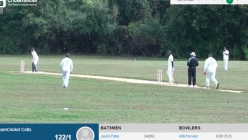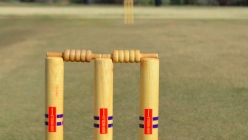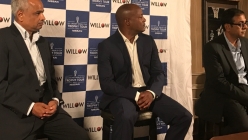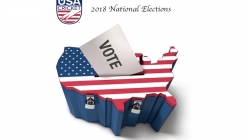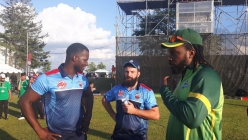USA Cricket: Impact of Gladstone Dainty's presidency on USACA's revenue. [Part 2]
2013 Jun 18 by DreamCricket USA
In 2011, US Lacrosse had registered membership of roughly 300,000 (which has grown to 400,000 now). USA Rugby had over 98,000 registered participants. USACA had fewer than 17,500.
Now, you can get all the USA Cricket updates via Facebook. Also follow us on Twitter via @dreamcricket
By Venu Palaparthi
This month marks the tenth anniversary of Gladstone Dainty’s reign as president of USACA. It was on June 4, 2003 that Gladstone Dainty was elected president for the first time.
In the first article of this series, I noted how, during Dainty's ten years in office, USA slipped in the world rankings from 13th to 23rd. Throughout the last decade, Team USA suffered the effects of hurriedly convened teams, inadequate high level practice and inconsistent selection.
A major reason for this slide was USACA's inability to achieve financial stability under Dainty's leadership. In this second article, I take a look at Dainty's success as a leader in enhancing participation rate, increasing revenue from its membership, and maximizing the potential for sponsorship and commercial development.
Participation and Membership Revenue
Among emerging sports, lacrosse and rugby have left cricket in the dust over the last decade. In fact, lacrosse (+41.8%) and rugby (+37.7%) showed highest participant gains over the 2007-2011 period according to Sports and Fitness Industry Association's 2012 survey of team sports.
In 2011, US Lacrosse had registered membership of roughly 300,000 (which has grown to 400,000 now). The sport also had 565,000 core participants in 2011 - players who played at least 13 games during the year. USA Rugby had over 98,000 registered participants and over 289,000 core participants.
In comparison, according to the 2011 ICC Census, USACA reported 16,680 core adult players and 750 junior players. USACA's registered membership and fees from membership are miniscule and many of the leagues are no longer members in good standing following the election year shenanigans from 2011-2012.
Outside of USACA's sphere of influence, participation rates for cricket in the USA have increased dramatically, mainly because of a continued influx of immigrants. During the last decade, numerous cricket leagues were formed, but they operate autonomously beyond the USACA radar.
Membership revenue has not kept pace with the growth in the number of cricketers in USA. In 2009, USACA reported that it received less than $30,000 in membership dues. As Stephen Rooke noted in this analysis of USACA's financials between 2000 and 2009: "If 2006 is omitted from the dataset, the average non-ICC revenue falls by sixteen percent to $46,522.57. This average is less than the revenue generated in 2002 and 2003, indicating that the USACA has been largely unable to increase its domestic revenue."
Just to give you an idea of how bad USACA has been in this area, consider this: USA Rugby received $3.2 Million from membership during 2011, up from $2.8 Million in 2010. That translates to roughly 40% of its overall revenues. For USACA, a bulk of its revenue came from ICC and from loans.
Overall, participation in cricket under Dainty's leadership is a story of - you heard it before - unrealized potential.
Sponsorships
 Corporate funding by US companies is what makes American sport tick. Cricket at the world level benefits hugely from sponsorships by US-based multinational companies such as Pepsi. USACA's track record in raising sponsorship dollars for the sport in USA has been abysmal.
Corporate funding by US companies is what makes American sport tick. Cricket at the world level benefits hugely from sponsorships by US-based multinational companies such as Pepsi. USACA's track record in raising sponsorship dollars for the sport in USA has been abysmal.
Pic (Right): Show us the money
It would be untrue to say that there are no sponsors for cricket in the USA. A smattering of small businesses - technology companies, a community bank or two, a few doctors - have faithfully supported and helped sustain local and regional level cricket events over the years. Cricket has also benefited from the generosity of a few individuals within the administrative ranks. Dainty himself is known to have spent a small fortune in addition to a considerable investment of time on cricket. USACA Treasurer John Thickett, 1st Vice-President Michael Gale and former 1st Vice-President Nabeel Ahmed have all supported cricket causes. Name a region and I can name individuals who have been involved in administrative capacity who have underwritten costs of tours, air tickets, lodging, meals, etc.
The New Inning Foundation started by Ram Varadarajan, Dainty's opponent in the last two elections, has donated money to cricketers and to cricket causes. Other altruistic donors such as Apple Pickers Foundation and ACF have supported certain events.
In the last month, USACA announced its first two sponsors in recent memory - a Houston-centric auto business and a Pakistani cricket equipment manufacturer. This is a modest start.
However, when it comes to the typical sports sponsors among the big corporations, there simply has not been an ambitious and energetic effort to generate sponsorship interest in the USA Cricket Association or the USA national team. In fact, American Collegiate Cricket supported by Coca Cola and TV Asia and USYCA, whose sponsors have included MetLife and Reebok, have outdone USACA on the sponsorship front.
It is pointless to even attempt a comparison of USACA with other sports that were similarly placed ten years ago. USA Lacrosse's sponsors include Champion, Marriott, Nationwide, Sports Authority and US Bank.
The trouble is that with corporate sponsorships come reasonable expectations surrounding return on investment, assurances of brand visibility and a level of accountability. Such expectations indicate that USACA needs to lift its game is an area where they have been found lacking.
Over the last three years, I have personally met or spoken to a half-dozen major sponsors, including a major airline and a big insurance company, who were stunned by the unresponsiveness of USACA. I once received a call from an acquaintance who worked at an industry leading marketing agency - he was on the USACA website but was unable to find any information on sponsorship.
Why is Dainty responsible for any of this? Well, besides being the supreme leader of USACA, he also sits on the USACA Commercial Committee.
In 1999, Ricky Craig, then President of USACA told Cricinfo: "We have got to become more savvy at what we do. There are a lot of corporate sources in the USA interested in sponsoring cricket. We have never approached them in a professional manner."
Under Dainty's leadership, the organization has struggled to get the basics right. Sample this: besides not having any sponsorship related information on the USACA website, there is no designated marketing contact, no information on the cricketing demographic, no list of specific event related sponsorship opportunities. There simply hasn't been a compelling plan to provide revenue-generating exposure to a potential sponsor.
Development of Commercial Rights
We have heard so many times of USA's great potential - how it is home to millions of cricket fans and the source of the second largest population of internet surfing cricket aficionados. Since the advent of T20 cricket, we have also seen proclamations regarding how well positioned USA was to take advantage of this format. Not to forget the untold riches that could be harnessed by organizing neutral venue cricket and a T20 league in the US.
As far back as 1996, Mark Mascarenhas' Time Out negotiated and signed a three-year contract with USACA that resulted in advance payments to USACA totaling $230,000 in 1996 and 1997. It was said that, for another payment of $39,000, Time Out was granted an extension of its rights until 2002.
"Essentially, our company would advance monies to the USACA and earn back this investment from fees received from the sale of television and sponsorship rights to international matches played here," Mascarenhas told Cricinfo in 1999. Around this time, there were also discussions that ICC was having with Disney directly to host cricket matches at the Wide World of Sport, prompting TimeOut to issue a "legal threat of action" to ICC for $10 million. In any event, long before Mascarenhas died in a car crash in 2002, the Time Out and ICC-Disney proposals faded in a storm of accusations. Even though these discussions preceded Dainty's tenure as president, he was most certainly aware of these deals. He was also the Treasurer for some of that time.
During Gladstone Dainty's tenure, major game-changing deals were announced on three occasions. If you will permit a cricketing analogy, this is how these efforts have progressed. The field was always set correctly, the run-up was perfect, the bowler was among the best, the ball was on target, but each time, the result was a no ball.
Project USA: In March 2003, almost the same time as when Dainty first entered office, the ICC announced the “Project USA” initiative with a start date of June 2003. The project entailed organizing four triangular ODI events in the USA at a cost of $12 Million. The ICC forecast revenue of $22 Million from organizing these events with the surplus of $9 Million going to USACA.
Infrastructure was a key issue that Project USA attempted to solve through the import of eight drop-in turf wickets from Australia and New Zealand. The idea was to store these drop-in pitches in green-houses in the off-season.
By March 18, 2005, the project was scrapped. An ICC statement said that "in light of the inability of the United States of America Cricket Association to address the fundamental governance issues of the game in the USA, the executive board decided to immediately terminate its initiative to stage international cricket in the USA to generate funds to develop the game in this country."
Ehsan Mani, the then ICC President, said: [T]he success of this project relies on having an effective governing body for cricket in the United States. Our experience in dealing with the USACA and the current controversy over the governance of the game in this country has convinced the board that it cannot support investing ICC members funds in this project and it has been terminated." The controversy in question was the one surrounding the 2005 election.
Centrex: After the demise of Project USA came news of a proposed agreement that USACA inked with Centrex International. The two were to form a joint venture marketing company - US Cricket Properties - that was to "revolutionise the way cricket is marketed in the USA." The joint venture would handle sponsorship, broadcast, media, promotional, merchandise and new media. In return, an amount in excess of $10 million was to be invested over a 10-year period in USA cricket.
"This is about investing and building a sport from the grass roots up," Archie Paton, a director of Centrex, said at the time.
Speaking about Centrex in an interview with Cricinfo in February of 2007, Dainty said: "Centrex share our desire to build a solid foundation for sustained success. They are capable partners as we strive to reach non-traditional cricket centres." "This will have a great impact on cricket in the USA," he said.
"It gives us the financial support and resource to really make a difference in how the sport is run at every level. It equally brings to the organisation a wealth of professional sports business experience that is critical if we are to succeed in expanding our sport. The board gave its unanimous support to the initiative and is very excited about the future."
The Centrex deal eventually vanished without a trace. A look at USACA tax statements from the period reveals that Centrex contributed a total approaching $25,000 in 2006 and 2007. In the 2011 Notes to Financial Statements, USACA's auditor noted that USACA actually took $50,000 in advance payments from Centrex, which was marked as a loan.
 CHALLC: In July of 2009, USACA made another fresh start and its request for proposals received 102 expressions of interest. By December of 2009, USACA and New Zealand Cricket (NZC) announced the commencement of formal discussions with the intention of establishing a strategic partnership agreement.
CHALLC: In July of 2009, USACA made another fresh start and its request for proposals received 102 expressions of interest. By December of 2009, USACA and New Zealand Cricket (NZC) announced the commencement of formal discussions with the intention of establishing a strategic partnership agreement.
(L to R) Neil Maxwell, Insite; John Thickett, USACA Treasurer; Gladstone Dainty, USACA President; Justin Vaughan, former CEO of NZC and Rajiv Podar of Podar Enterprise sport USA Cricket caps at the conclusion of the signing agreement in Beverly Hills.
Exactly a year later, in December 2010, Gladstone Dainty, President of USACA announced the creation of Cricket Holdings America LLC (CHALLC) : “I am delighted the hard work has resulted in a well-resourced outcome that provides USACA with the ability to grow the game from “grassroots” to the elite level. We are very excited about this partnership. It should open the door for private investment into cricket in America, one of the more exciting new market opportunities for the ICC.”
"This partnership will provide cricket in the US two very clear benefits. Importantly, it will provide a sustainable revenue stream for the development of the game and secondly, we shall be supported by the knowledge and expertise that comes from a Full Member country like New Zealand. These two compelling benefits will assist us to give cricket a strong foothold in the United States,” Dainty added.
Once again, the field was set. Only, this time the stakes were higher. USACA can no longer afford another failure.
Two and a half years have passed since the deal was signed. As for progress, you be the judge. According to USACA's 2011 Financial Statements, USACA received $770,000 in advances during 2010 and another $1.1 Million in 2011 from Top Bloom and Insite, both of which are CHALLC's stakeholders. These amounts were being treated as commercial loans. USACA has not received any fees so far and CHALLC has not yet earned any revenue from its rights. According to news reports, the rights for the last set of T20 matches in Florida between West Indies and New Zealand in 2012 were sold by CHALLC for $1. The planned US T20 league has been pushed back from 2012, first to 2013 and it now hopes to launch in 2014.
There is also no positive news yet about CHALLC's success with persuading another investor to join, an event that could potentially result in a $3 million bonus payment to USACA.
The present sentiment about USACA is not exactly bearish as in the past, but that of cautious optimism, in large part due to the involvement of New Zealand Cricket and the approval of the ICC. It also helps that CHALLC's primary investor is still backing the deal.
"There have been some delays, mainly due to detailed planning and putting a proper structure and plan together. Given the magnitude of the project and our desire to have a world-class event, delays are normal. Frankly, I do not see how this is going to be a potential danger in ending the league. The company is being financed and progressing as planned," CHALLC's primary investor Rajiv Podar was quoted in ESPNCricinfo in December 2012.
Overall, if you consider membership revenue and sponsorships, the impact of Dainty's presidency has been negligible. The verdict is not out yet on Dainty's performance on commercial deals. Maybe USACA will be fourth time lucky and Dainty's ten years will eventually yield something long-lasting.
